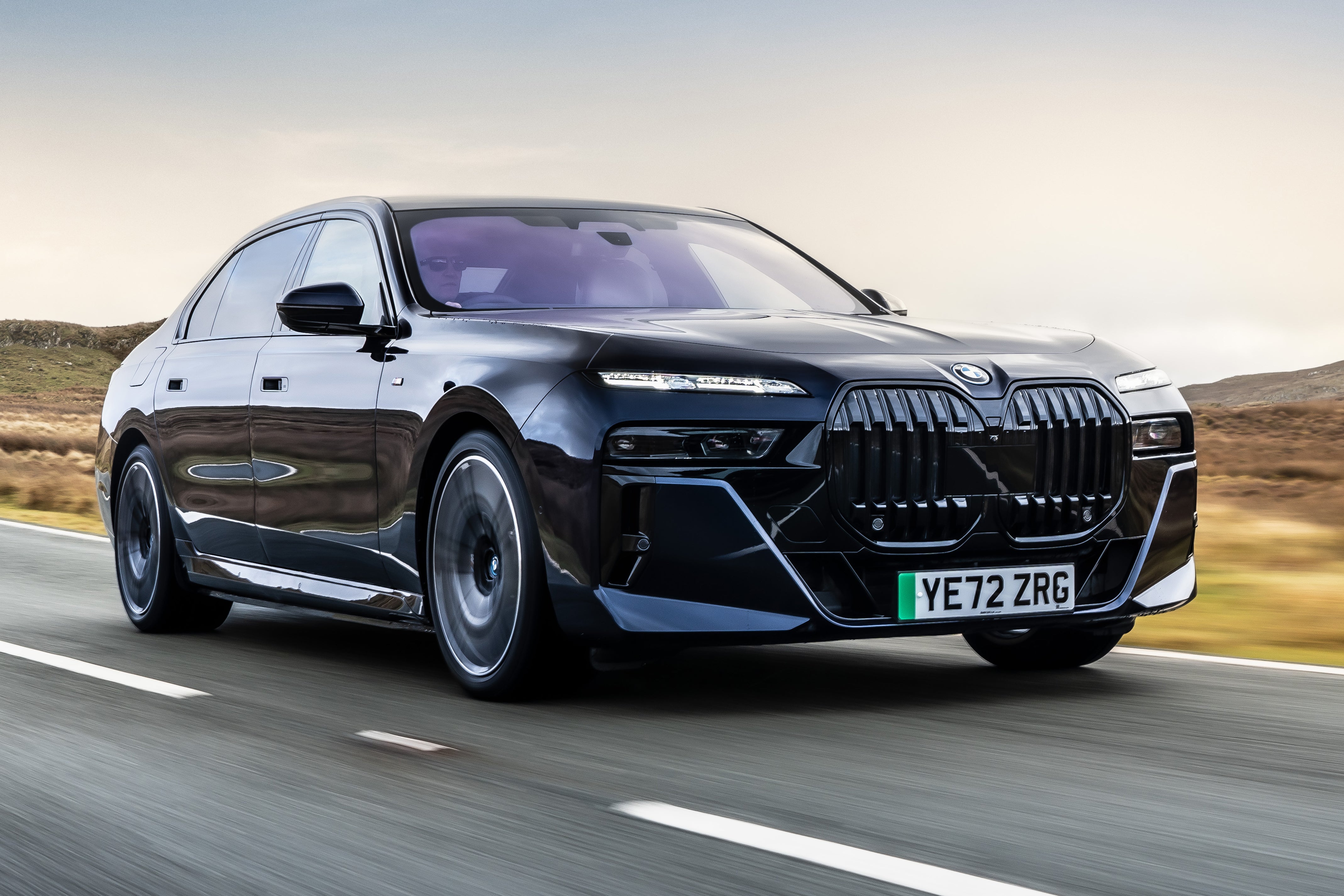BMW i7 Review 2025: Price, specs & boot space
Written by Ivan Aistrop
Quick overview
Pros
- Fabulous to drive in every way
- Gorgeous interior quality
- Astounding technology on offer
Cons
- All versions are hugely expensive
- Small boot compared with rivals
- Some annoying gimmicks
Overall verdict on the BMW i7
"Luxury limousines don’t get any better than the BMW i7. It delivers peerless comfort and refinement and it has the quality to make rivals feel positively second-rate. If your pockets are deep enough, it also offers a level of technology and entertainment functionality that’ll make your jaw drop, but even without all that stuff, it’s still the best car of its type"
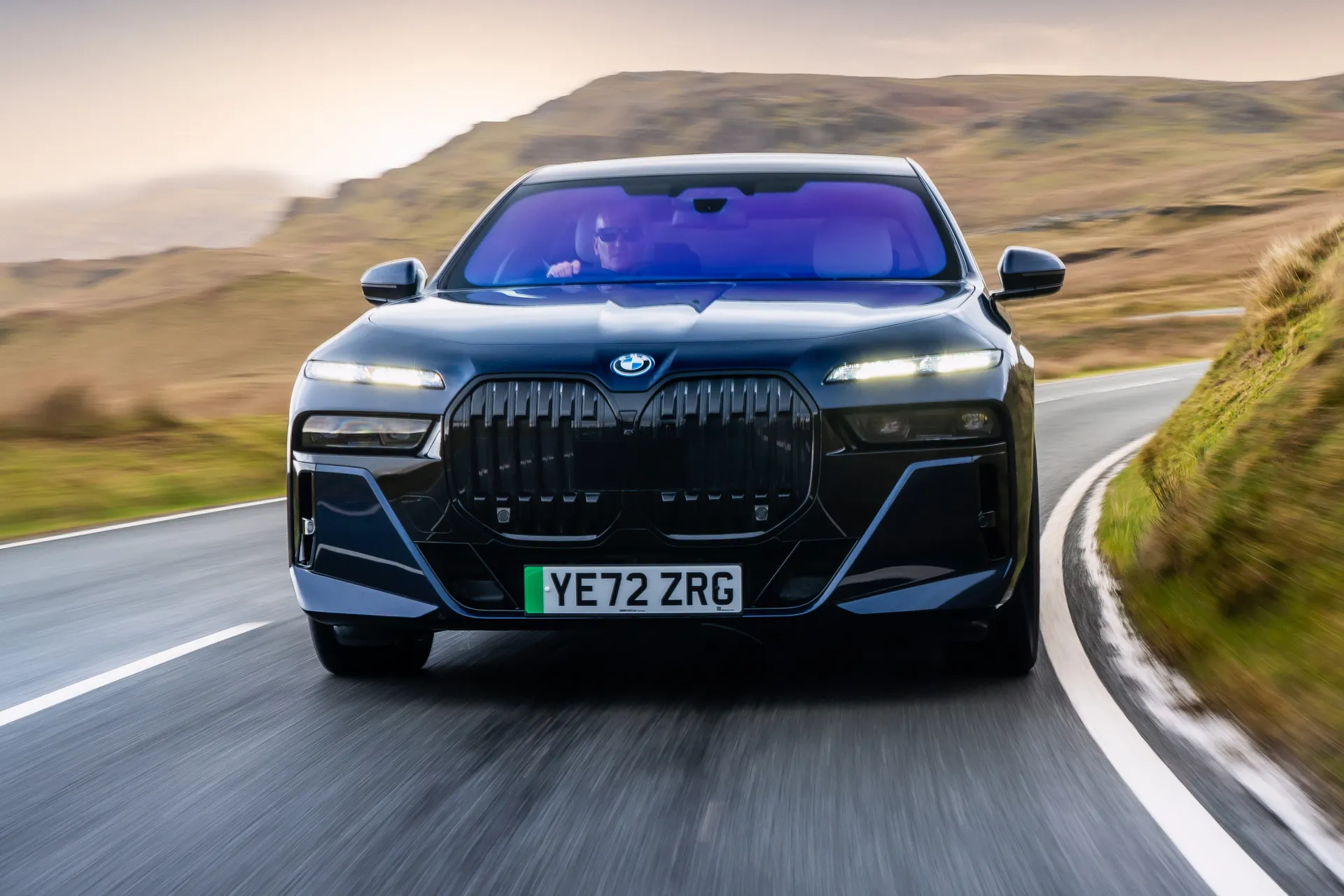
For many years, the 7 Series has been BMW’s flagship, showcasing all the company’s latest and greatest cutting-edge technology. With the latest BMW i7, however, the car itself is the cutting edge bit. As the all-electric version of BMW’s luxury limo, it shows the very future of the 7 Series, not to mention the brand as a whole. Find out everything you need to know in our BMW i7 review.
On the face of it, this car looks like a festival of excess. There are three powertrain options available, all with a huge 101kWh battery pack and official ranges upwards of 340 miles. They all have blistering performance, too, and every version costs north of £100,000. Now, that might sound vulgar to some, but once you get up close and personal with the BMW i7, you start to understand that astronomical cost.
For example, just look inside: this thing is beautiful. Any luxury limo needs to have the quality and attention to detail to make its occupants feel like they’re travelling in first class, but the BMW i7 has a plushness that outshines the Audis and Mercedes it competes with. There’s acres of space to stretch out, and even in standard form, there’s a lot of luxury kit to keep you comfortable and entertained.
The way the car drives will also make you feel like a high-roller. With huge amounts of near-silent electric propulsion at your disposal, plus a suspension that isolates you from the vulgarities of the road surface and a cabin that shields you from the noises of the outside world, you’re whisked along in effortless comfort and serenity, with only the temptations of the car itself to distract you from your business.
And there are plenty of those temptations, although if you want to experience the most lavish you’ll either need to fork out for one of the high-spec ‘Pro’ versions or get busy with the options list. Choices include a rear seat that reclines almost horizontally with its built-in leg rest, aeroplane-style, and doors that open themselves without you having to touch them.
The thing that really marks the BMW i7 out from luxury limo rivals, though, is what BMW calls Theatre Screen. This is a huge 31.3-inch 8k digital screen for rear-seat occupants that folds down electrically from the ceiling at the touch of a button. You can watch on-demand video on the move thanks to Amazon Fire TV and YouTube integration, and it’s all controlled with slick 5.5-inch touchscreens built into the rear doors. If you’ve ever wanted to hit motorway speeds in your own personal home cinema, well, now you can.
Yes, the BMW i7 is astronomically expensive, but it is nevertheless a technological tour-de-force. And even without all the gadgetry, it’s still the best car of its type in a variety of other ways.
Looking for a used car for sale? We've got 100s of BMW Approved Used Cars for Sale for you to choose from, including a wide range of BMW i7 cars for sale.
Is the BMW i7 right for you?
If you’re a well-heeled exec with money to burn, and you’re after a comfortable, relaxing, tranquil and tech-laden way of getting from meeting to meeting – preferably with someone else doing the driving – then the BMW i7 is most definitely for you. It’s one of the best cars of its type, and one of the finest luxury cars we’ve ever come across. And if you can get your company to pay for it, so much the better.
What’s the best BMW i7 model/engine to choose?
Quite honestly, we can’t see much reason to look past the first rung on the BMW i7 ladder, which is the eDrive50 Excellence. Even the most basic version is outrageously fast, beautifully appointed, stuffed with luxury equipment, and effortlessly comfortable and refined to drive or be driven in.
This version is still expensive at more than a hundred grand, but you don’t have to move too much further up the range before prices become even more laugh-out-loud ridiculous. That said, if you want the full theatrical audio-visual experience that the BMW i7 has to offer, you’ll either need to upgrade to one of the more expensive models, or throw a bunch of ticks at the options list.
What other cars are similar to the BMW i7?
Like other non-electric members of the BMW 7 Series family, the i7 competes with traditional luxury limousine rivals such as the Audi A8 and Mercedes S-Class. However, as part of the new wave of electric cars hitting the market, there are also various battery-electric competitors to contend with, such as the Mercedes EQE and EQS, plus the older Tesla Model S. If you’re not 100% sold on the idea of a saloon and fancy a luxury SUV instead, there are plenty more options, such as the Audi Q8 E-Tron, the Mercedes EQS SUV and the Tesla Model X.
Comfort and design: BMW i7 interior
"Even as standard, the i7’s interior provides all the space and luxury that the most demanding executive could ever want, with gorgeous quality and lots of luxury kit. Choose a higher-end model or raid the options list, meanwhile, and you can have access to some hugely theatrical features."
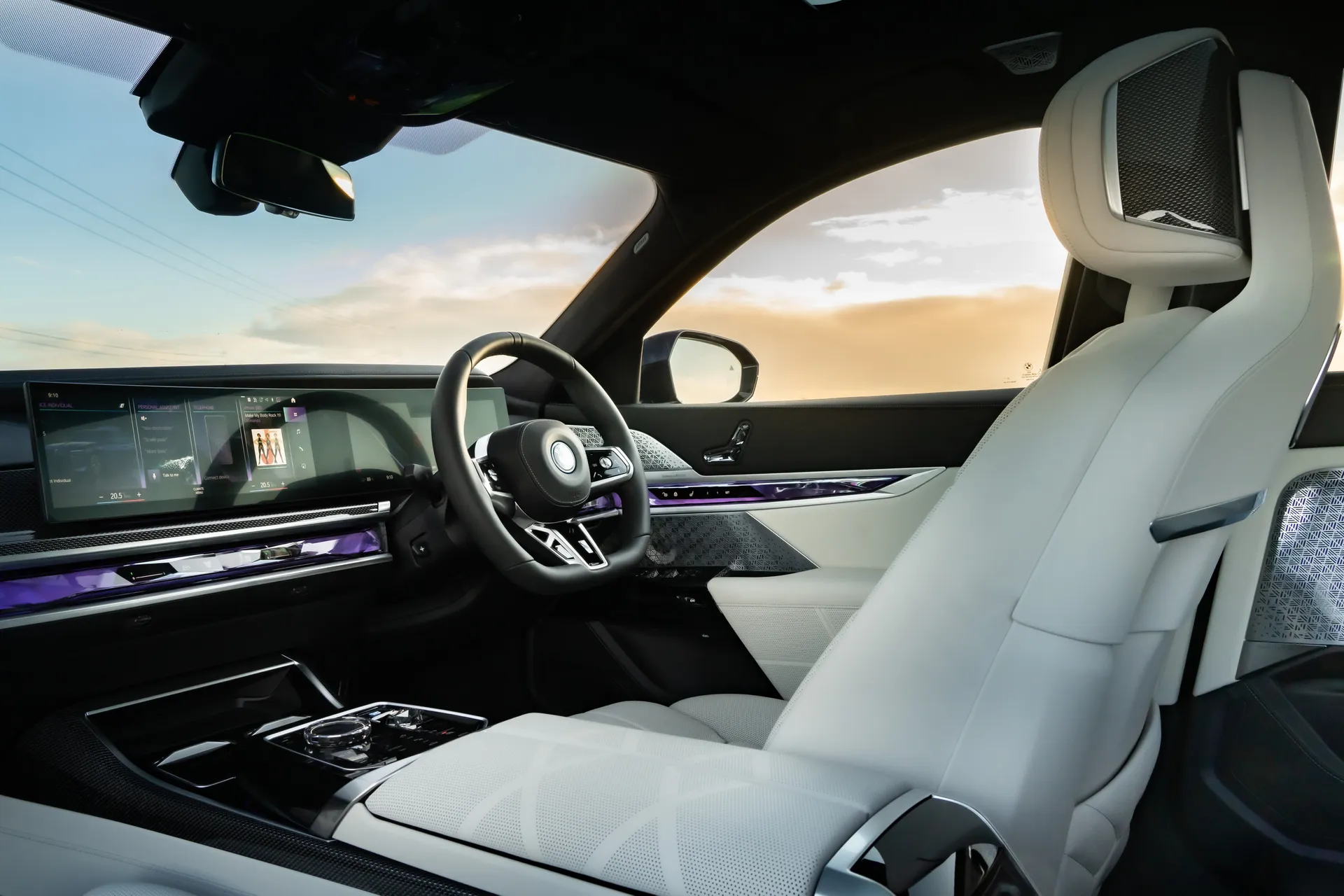
The driving position in the BMW i7 is absolutely spot on, because the pedals and steering wheel line up straight and true with the driver’s seat. All versions come with extensive electric adjustment for the seat and steering column, so it’s as easy as pie to fine-tune your position. Your all-round visibility is great, too, which is just as well given the immense size of the car, and you have 360-degree cameras and parking sensors all over the place as backup, should you need them.
The amount of switches and buttons on the dashboard itself is drastically reduced by how many functions are controlled by the touchscreen (more on that in a moment), and that includes the ventilation system. We always prefer physical buttons and dials for this because they’re easier to use on the move, but at least there’s a shortcut icon to the climate menu at the bottom of the screen that’s displayed at all times.
You’ll also notice what BMW calls the ‘Interaction Bar’. This is a piece of spangly trim that runs the full width of the dashboard and into the front doors. It’s part ambient lighting and part control mechanism, with touch-sensitive controls for various functions incorporated within it. It’s sensitive enough to prods and it works reasonably well, even if some might view it as something of a gimmick.
Quality and finish
As a luxury limo, the BMW i7 has some pretty classy competitors to contend with from the likes of Audi and Mercedes. You’ll have no worries of an inferiority complex if you plump for the Beemer, though, because the i7 has them matched and surpassed when it comes to quality.
Every single surface and finish you come into contact with feels effortlessly plush and reassuringly expensive, which makes the BMW i7 the luxurious environment that it should be. The slick precision of the controls helps towards the substantial feel of the car, too.
Infotainment: Touchscreen, USB, nav and stereo in the BMW i7
If you’re a tech fan that likes your car to have the latest and greatest infotainment functionality, then you’ll be truly blown away by the BMW i7. All versions feature the same twin-screen system that combines a 12.3-inch driver display with a 14.9-inch central screen in a single curved unit that stretches more than halfway across the dashboard. If that weren’t enough for you to be looking at, you also get a head-up display as standard.
The system supports all the functionality you expect, such as DAB radio, Bluetooth, wireless phone charging, augmented-reality sat-nav, Apple CarPlay and Android Auto. You also get a powerful Bowers and Wilkins stereo. Like most such systems these days, touchscreen functionality is supported, but you can also control the system by twiddling and pressing a rotary dial between the front seats to scroll through on-screen menus, which is far less distracting when you’re driving.
The system is a little complicated to use, just due to the sheer amount of functionality it has, but given time and familiarity, you should get used to how it works.
However, that’s not the half of it. BMW also offers something called Theatre Screen, which you can buy either as an individual option, as part of an option pack, or by choosing one of the Pro models. Theatre Screen is a 31.3-inch 8k digital screen that folds down electrically from the ceiling in front of the rear seats at the touch of a button. It has built-in Amazon Fire TV and YouTube streaming, so you can watch on-demand video on the move, or you can hook up your own media for playback
What’s more, the system is controlled – along with the rear climate control, rear-seat heating settings, and other functions – via 5.5-inch touchscreens built into the rear doors. It all looks incredibly swish, and lends the sort of high-tech feel that few cars at any price can match.
Space and practicality: BMW i7 boot space
Limousines are designed to give their well-heeled occupants plenty of space to lounge around, and that’s precisely what the BMW i7 does. At almost 5.4 metres long, it’s one of the lengthiest cars on sale, and so it’ll be no surprise that legroom is absolutely gargantuan in those all-important back seats. Even if your chauffeur is built like a Harlem Globetrotter, there will be several inches between your knees and the seats in front of you.
Sit on the other side of the car, and you can have even more legroom by electrically moving the front passenger seat: it slides a long way forwards into its footwell and the backrest tips forward for even more space behind. Headroom is also generous, despite all i7s coming with a panoramic roof as standard.
If you want the back of your BMW i7 to be even more luxurious, you can add the Executive Lounge seats. This adds a cleverer seat on the passenger side, which adds gapless leg support and an improved reclining range, making it feel like a first-class airline seat.
The boot isn’t quite so impressive on the BMW i7. At 500 litres, it’ll have enough space for a number of Gucci suitcases, but rivals from Tesla and Mercedes provide quite a bit more space, and their hatchback openings give better access than the BMW i7’s rather tight saloon boot opening. The fixed rear seatbacks also means you can’t drop the rear seats for bigger loads, either, although there is a small ski hatch for limited through-loading.
Handling and ride quality: What's the BMW i7 like to drive?
"The best luxury limos have to be comfortable and quiet above all else. Those are both briefs that the BMW i7 absolutely nails, yet it also manages to throw in scarcely believable handling ability for a car of its size, too."
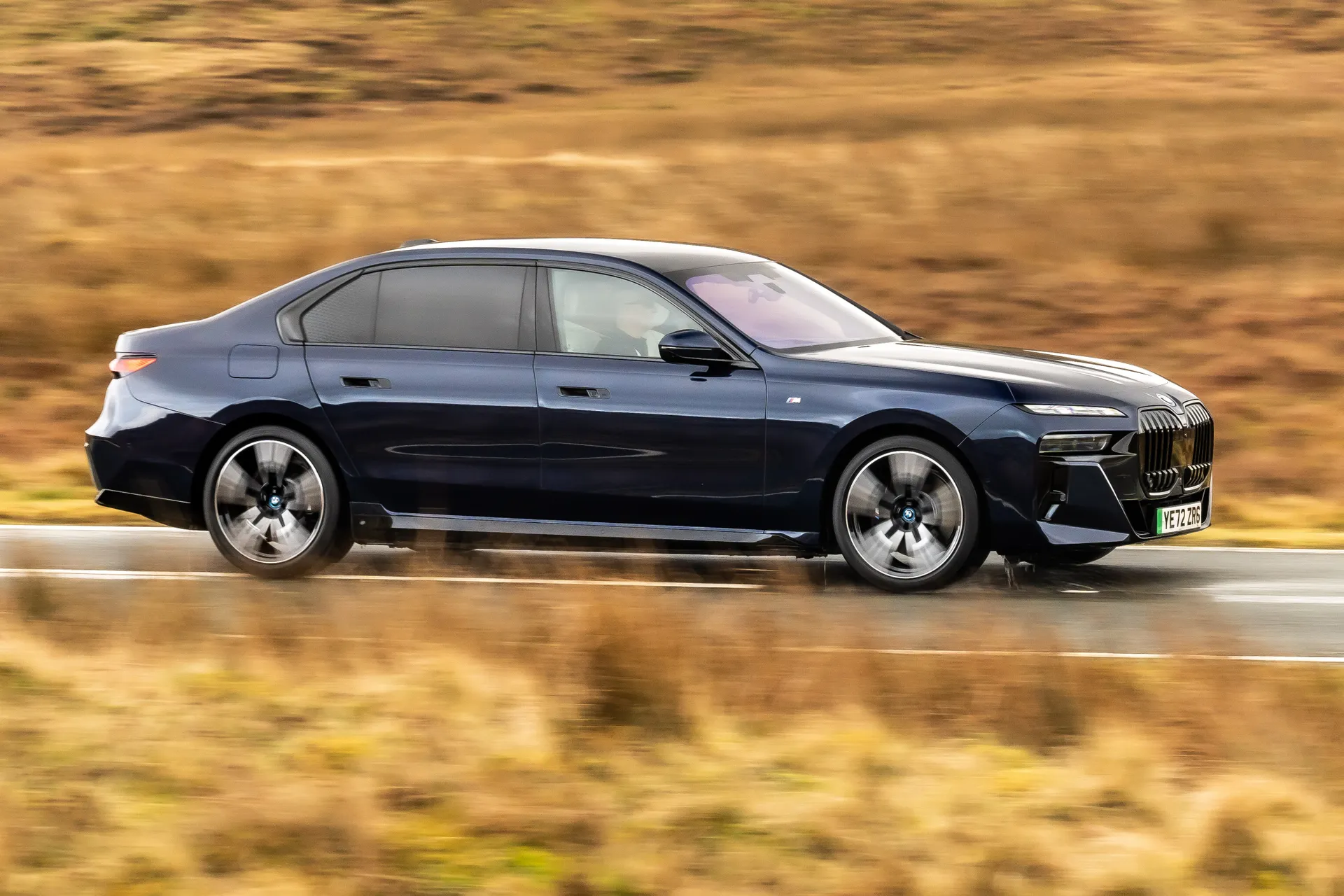
The type of suspension you get on your BMW i7 depends on which version you go for. Stick with the eDrive50 or xDrive60 in Excellence or M Sport trims, and you get the standard air suspension, which is sensational. It keeps the ride effortlessly cosseting, with poor surfaces of all types smoothed out really effectively, and that’s the most important thing about the driving experience of any luxury limo.
As a bonus, the car changes direction way more crisply than you expect given its size and weight, with really impressive body control, huge grip and steering that feels connected and assured. Even in this form, we’d say the i7 is the best car of its type to drive overall.
Go for one of the Pro models, or the BMW i7 M70, and you get something called Executive Drive Pro. This is basically a system that can ‘read’ the road ahead, assess its condition and the nature of the bumps and ruts that lie in wait, and adjust the suspension accordingly to deal with them most effectively. It also has active roll stabilisation for flatter cornering. We haven’t tried it yet, but given how good the standard setup is, it’ll have to go some to be worth the extra outlay.
What motors and batteries are available in the BMW i7?
The BMW i7 is available with three different powertrain options, and so far, we’ve only driven the entry-level one. Not that it gives entry-level performance, mind. The eDrive50 has a single motor on the rear axle, but this motor delivers a stonking 455PS, allowing this enormous 2.6-tonne lump to rush from 0-62mph in just 5.5 seconds.
Even in this most basic of forms, the i7 feels indecently fast, and any meaningful squeeze of the accelerator pedal results in properly strong and swift pickup, whether you’re getting away from the mark or putting your foot down when already on the move.
Things only get more indecent as you move up the range. The xDrive60 adds a second motor on the front axle to bump the output up to 544PS, and also adds four-wheel-drive traction, meaning that the 0-62mph dash is dealt with in just 4.7 seconds. Upgrade to the range-topping M70 xDrive version, meanwhile, which replaces the rear motor with a brawnier one, and you’ll get a total output of 659PS, making it BMW’s most powerful M car to date, while also allowing a 0-62mph time of just 3.7 seconds.
Maximum electric range in the BMW i7
All versions of the BMW i7 get the same battery pack, which has a total capacity of 105.7kWh and a usable capacity of 101.7kWh. The range you get depends on which powertrain and trim level you select (mainly due to weight and wheel sizes). According to official figures, the maximum you’ll get on average will be from the xDrive60 in Excellence trim, with a total of 387 miles, while the worst average you’ll get will come from the range-topping BMW i7 M70 xDrive, with a total of 343 miles.
As ever, however, those laboratory figures should be treated with a degree of cynicism, because recreating them in the real world will depend on a vast amount of variables. Driven in moderate conditions in a variety of different circumstances, we’d anticipate a real-world range of between 280 and 320 miles, depending on the version, and if the weather is cold or you’re doing mainly motorway miles, expect considerably less.
Refinement and noise levels
This is a hugely important area for any luxury saloon, because a limo needs to be a calm and tranquil environment for its important occupants, and it’s an area that the BMW i7 absolutely nails. Get the car to a steady cruising speed, and you’ll hear barely any wind or road noise to speak of, and with no combustion engine chuntering away, things are almost as quiet as they’d be if the car was stationary.
Picking up speed can be an oddly undramatic affair, too, given the prodigious levels of power and acceleration available, and that’s because the pickup is accompanied by very little sound. There is a caveat to that, though. Depending on which of the driving modes you’ve selected, you’re served up one of a variety of different synthetic sounds that BMW proudly proclaims were developed alongside movie composer Hans Zimmer, and these futuristic whooshes and whines are designed to make your journey either more relaxing or more theatrical. We’re sure some drivers will like this feature, but we’re also sure that plenty of others will find it too much of a gimmick, and switch it off immediately.
Safety equipment: How safe is the BMW i7?
The BMW i7, along with the 7 Series on which it’s based, has yet to be tested by the safety experts at Euro NCAP, so we don’t yet know how it’ll fare in a crash.
Hopefully, though, it should be quite adept at avoiding one in the first place. Standard equipment includes BMW Driving Assistant, which includes driver aids such as Lane Change Warning, Rear Cross Traffic Warning and Brake Intervention, Rear Collision Protection, and Exit Warning.
Upgrade to one of the Pro models, and you’ll also get Driving Assistant Professional, which adds more driver aids on top. These include Steering and Lane Control Assist, Emergency Stop Assistant, Automatic Speed Limit Assist, Lane Change Assist, Lane Departure Warning and Front and Rear Cross Traffic Alert.
Charging times: How much does it cost to charge the BMW i7?
"The i7 is capable of some very impressive DC rapid charging speeds, so juicing it up shouldn’t take too long provided you can find a powerful enough public rapid charger. The huge battery will take quite a while to charge at home, though."
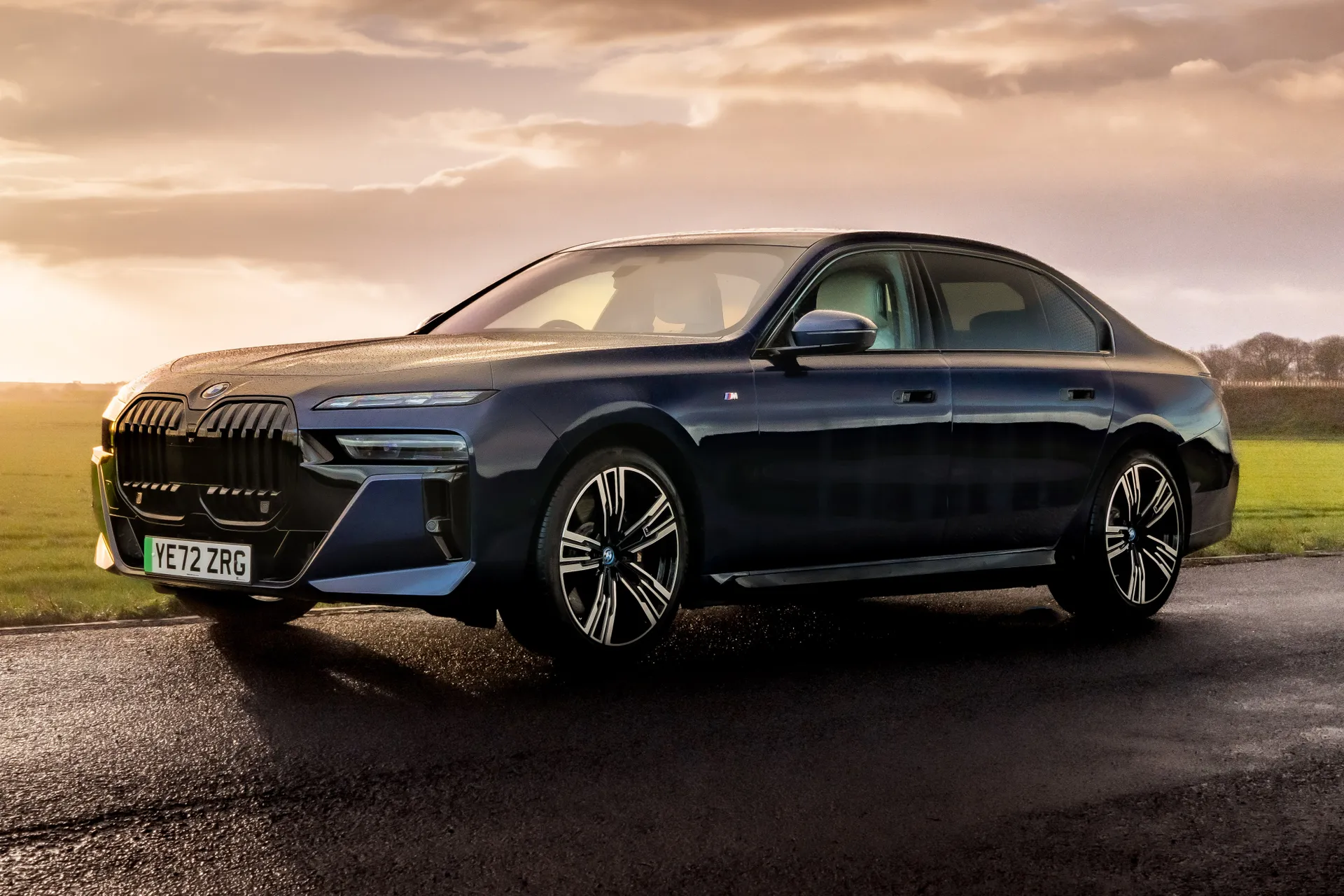
The BMW i7 comes with a massive 101.7kWh battery pack, so charging it up isn’t going to be the work of a moment. Plug it into your average 7.4kW home wallbox charger, as most owners will, and it’ll take a little over 16 hours to climb from 0-100%. However, find a powerful enough public DC rapid charger, and the car’s maximum charging speed of 195kW can deliver a 10-80% juice-up in as little as 34 minutes.
The cost of public DC rapid charging varies wildly, but assuming a UK average price of 74p/kWh, that 10-80% top-up we talked about would cost somewhere in the region of £53. A full charge at home at the national average of 27p/kWh would cost more like £25, and on the cheapest overnight tariffs, that would drop to less than £15.
How reliable is the BMW i7?
Look at the latest instalment of the HonestJohn.co.uk Satisfaction Index, and it looks like BMW does an entirely reasonable job in this area, without exactly dazzling. In the overall satisfaction rankings, BMW came 12th out of the 29 brands considered, which is about as fair-to-middling as it gets.
For reliability specifically, the brand didn’t feature in the list of the ten worst manufacturers, but by the same token, it didn’t feature in the list of the ten best, either. BMW did have one model (the 3 Series Touring) feature in the list of the 20 most reliable cars in the study, but it also had two models (the 2 Series Active Tourer and i3) feature in the 20 least reliable cars.
When it comes to the reliability of the BMW i7 itself, we’ll just have to wait until there’s more data before we can make any sort of judgement.
Insurance groups and costs
When all versions of the BMW i7 cost upwards of £100,000, and boast an extraordinary amount of power, it’s perhaps not surprising that all variants sit in the highest group for insurance, group 50. This obviously means that premiums won’t be cheap, but to be fair, if you’re wealthy enough to run a car as expensive as this in the first place, then the price of insurance is unlikely to phase you.
VED car tax: What is the annual road tax on a BMW i7?
Normally, if you have a car that costs over £40,000 when new – which the BMW i7 does, and by some considerable margin – then your annual Vehicle Excisde Duty bill will include a £390 ‘luxury car’ surcharge for a five-year period between years two and six of the car’s life, taking your annual £180 flat-rate charge up to £570.
However, because the BMW i7 is electric, it’s exempt from all VED charges, including both annual fees and the large lump sum you pay when you buy (although this is rolled up into the car’s list price, so you often don’t notice it). If you’re wealthy enough to buy an i7, you’re unlikely to miss the few hundred quid a year this will save you, but it might satisfy you to know that you’re handing less money to the Exchequer – at least until 2025, when the VED rules change and electric cars will become chargeable (no pun intended).
How much should you be paying for a used BMW i7?
"The i7 is a big, powerful electric BMW, so you wouldn’t expect it to come cheap, and it really doesn’t. However, luxury cars like this don’t tend to hold their value awfully well, so scouring the used car market can result in some big savings.”
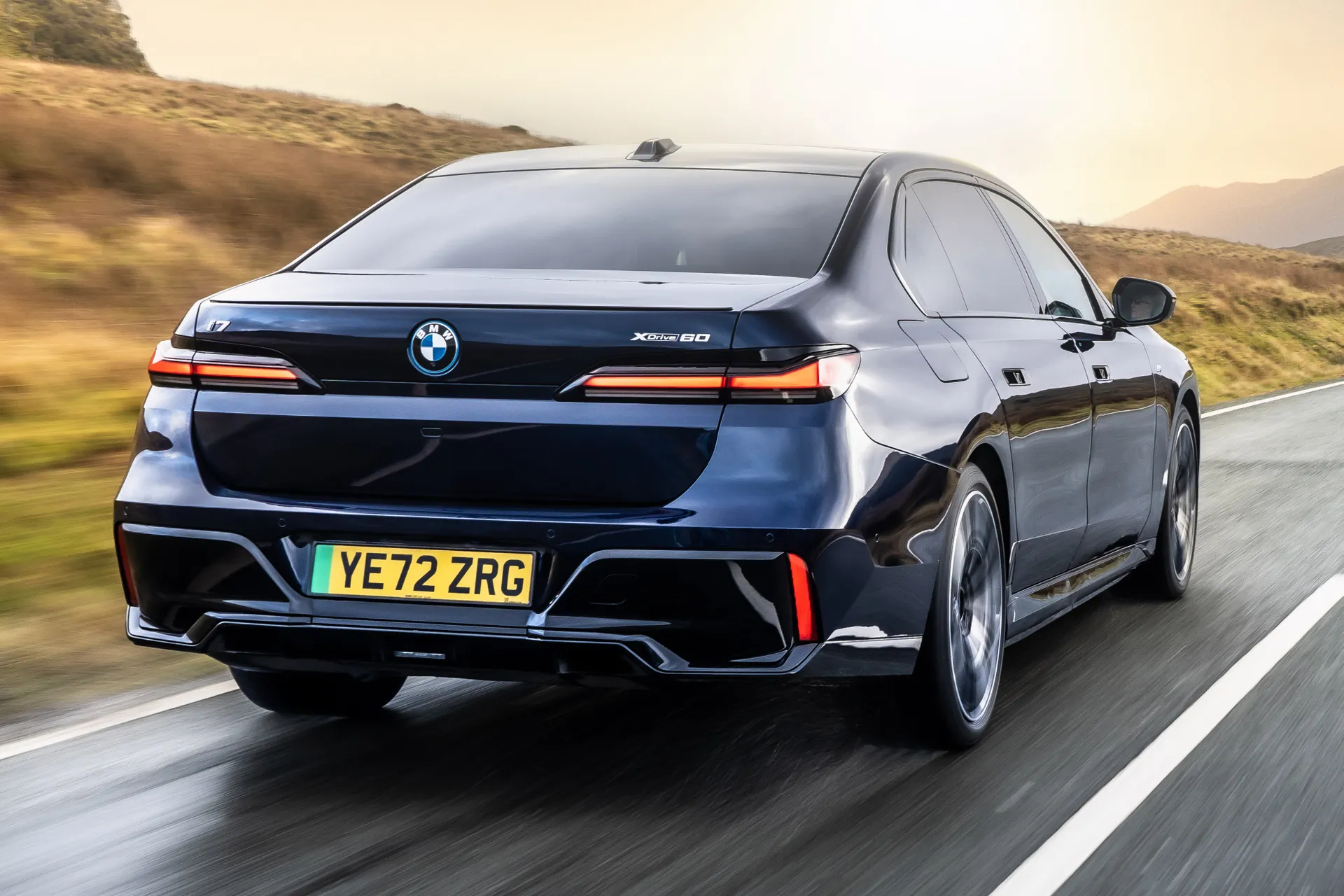
Nobody would expect the BMW i7 to be a cheap car, and indeed, it really isn’t. Even the cheapest version costs upwards of £100,000 when bought brand new, and you don’t have to climb too far up the range of powertrains and trim levels before prices start spiralling ridiculously quickly. Spec the range-topping M70, and you’ll be forking out more than £160,000, and that’s before you’ve started ticking options boxes.
Buying used could be a sensible way forward, however, because cars like these tend to shed their value comparatively quickly. Our listings show several nearly-new cars with less than 5000 miles on the clock for a handy five-figure saving compared to a brand new version, and what’s more, you won’t have to wait for the car to be built and shipped.
Trim levels and standard equipment
It seems ludicrous to use the term ‘entry-level’ when talking about a car that costs upwards of a hundred grand, but nevertheless, the entry-level version of the BMW i7 is called the Excellence. As you’d expect, it comes loaded with equipment and technology. Aside from all the infotainment and safety gadgetry we’ve already mentioned, it looks the part with 19-inch alloy wheels, an illuminated grille, metallic paint and adaptive LED headlamps, and you also get a powered bootlid, power folding door mirrors, soft-close doors, four-zone climate control, front and rear heated seats, leather upholstery, a panoramic roof, an internal camera, automatic lights and wipers and air suspension.
Next up is the BMW i7 in M Sport trim, and this adds sporty styling goodies including 20-inch wheels, a variety of dark-coloured exterior trim pieces, M Sport brakes with blue calipers and an M Sport steering wheel, but that doesn’t sound like an awful lot for the extra four and a half grand that you pay.
Then come the Excellence Pro and M Sport Pro trims. These cost upwards of 20 grand more than the basic trims that they’re based on, so they’re not cheap upgrades. For your money, you not only get the dramatic Theatre Screen mentioned earlier in the infotainment section, but also automatic doors that open themselves with a touch of the door handle, ventilated front and rear seats that will also massage you, electric window blinds, a ‘SkyLounge’ panoramic roof (which has additional ambient lighting elements), and the road-reading suspension system. M Sport Pro models also get some additional styling pieces, such as a rear spoiler.
The standalone M70 xDrive version is the most expensive by virtue of having the most power, but its spec level is actually closer to M Sport than to M Sport Pro. That said, you do get yet more styling enhancements, upgraded brakes, ventilated and massaging front seats and the cleverer suspension.
Ask the heycar experts: common questions
Is the BMW i7 a good car?
How much does a BMW i7 cost?
What is the range of a BMW i7?
Get our latest advice, news and offers
Keep me updated by email with the latest advice, news and offers from heycar.
By submitting you agree to our privacy policy
